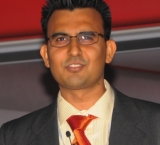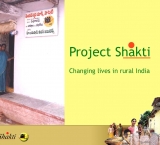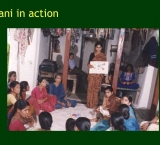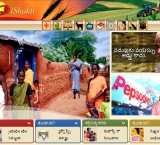Story:
Doing Well By Doing Good - Changing Lives in Rural India
By empowering women in Rural areas and enabling them to earn a livelihood, Project Shakti at Hindustan Unilever is a heart-warming story about doing well by doing good. It is principled, patient and embeds social goals into an organization’s innovation agenda and processes.

Hindustan Unilever Limited (HUL) is one of India's largest fast moving consumer goods companies and is owned by the European company Unilever, which owns a 52% majority stake. HUL began its operations as Lever Brothers in India in the summer of 1888, when crates full of Sunlight soap bars, embossed with the words 'Made in England by Lever Brothers' were shipped to the Kolkata harbour and it began an era of marketing branded fast moving consumer goods (FMCG) in India. HUL was formed in 1933 as Lever Brothers India Limited and came into being in 1956 as Hindustan Lever Limited through a merger of Lever Brothers, Hindustan Vanaspati Mfg. Co. Ltd. and United Traders Ltd. It is headquartered in Mumbai, India with an employee strength of over 15,000 and contributes to indirect employment of over 52,000 people. In June 2007, the company was renamed “Hindustan Unilever Limited”.
Hindustan Unilever's distribution covers over 1 million retail outlets across India directly and its products are available in over 10 million outlets in the country making it a distribution behemoth in a country with fragmented retail trade. Two out of every three Indians use its many home and personal care products, food and beverages. HUL is the market leader in Indian consumer products with a presence in over 20 consumer categories such as soaps, tea, detergents and shampoos amongst others with over 700 million Indian consumers using its products.
Unilever’s project Shakti was born in December 2000 in a district called Nalgonda in Southern India state of Andhra Pradesh. The idea inspired by a social objective was to provide sustainable livelihood opportunities for underprivileged rural women. In many Indian languages Shakti means strength or empowerment.
Over 70% of India’s 1 billion population live in rural villages where per capita income is less than half of that in urban India. Managers at Hindustan Lever faced significant challenges in order to get the project of the group. India may well be the worlds biggest democracy but it is far from being homogenous. In fact, diversity is its greatest strength but also its greatest challenge. Project Shakti, and any project tackling the informal markets of the world has to understand the territory. Five of India’s States were enthusiastic supporters of Shakti but others were even hostile. Closely linked to the prosperity of the State was the level of infrastructure and that impacted accessibility and viability of the project. Cultural issues varied in strength. For example, the status of women in rural society differed across states. In some places the idea of a woman venturing out of her home to sell products in other homes was anathema. And the language issue cannot be underestimated in a country with 27 official languages. Project Shakti operated in 12 languages and then dialects made even this level of communication difficult. Above all, the challenge of building up the self confidence and motivation of these underprivileged women as they came to terms with their Shakti status cannot be underestimated.
There were three innovations at the heart of the Shakti model.

1. The Shakti Entrepreneur: Underprivileged rural women are appointed as Shakti Entrepreneurs (SE’s) and trained to sell HLL’s products. These Shakti entrepreneurs sell directly to homes in their villages and earn a commission in the process. They help build brands in rural India on the basis of 1 on 1 interactive communication and over a time become a network of local, credible brand endorsers. In the process they are able to earn a substantial monthly income for the family that often results in the doubling of the household income.

2. The Shakti Vani: This is a Branded communication program that covers the important subjects of health and hygiene as well as women’s empowerment. A woman from a village is recruited as Vani and trained to communicate and given essential tools. She communicates at schools, SHG meetings, village gatherings, and other social fora. For this purpose she is given specially designed communication material in the form of a easy-to-carry kit that contains flip charts, leave-behind posters, banners. The content is developed after in-depth understanding of the local context. This works very effectively as a low cost communication tool for media dark regions is comes at half the cost of conventional rural communication models.

3. iShakti: This is essentially a rural community portal that creates access to information. A Desktop computer is set up in Shakti entrepreneurs’ homes. From this portal critical content can be accessed such as : Agriculture, health, veterinary services, education, employment opportunities, education, personal grooming, entertainment, games. Villagers can register as users and use a log-in id to surf content areas of interest. All content is backed by local language voice-over, allowing illiterate users to surf and access information. On all content areas, users can pose queries seeking information not available on the site and an expert panel is retained to answer queries. These queries and answers are updated once a day by dial-up.
All of these were introduced initially in the state of Andhra Pradesh in partnership with the Government.
There were several challenges in the implementation of this program. Right on top of the list was the lower margins that the organization would make on account of selling to Shakti Ammas at subsidized rates.
Project Shakti operated in media dark areas where television advertising could never reach. It moved the marketplace frontline away from local outlets who would champion other products into the homes of families in the remotest of areas. This meant that it was resisted by the shop keepers.
Husbands of the Shakti ammas prevented some of them from leaving the houses to do their daily sales for a while before finally being won over by the significant income they started to bring into the household.
All of these were largely mindset related and once it played out and the benefits became visible, it was rapidly embraced by the community as well as the organization.
The benefits from the project were staggering. In a matter of 12 months there were over 13,000 Shakti entrepreneurs across 12 states. The 2004 exit rate was clocking sales to 500,000 homes per month. This momentum resulted in a further expanison of the project and by the end of March '05 the Shakti Ammas were reaching 1 million homes per month.
Today the 40,000 women, or Shaktiammas, make about Rs. 1,000 a month by selling company products to other women as well as shops in their village. (People familiar with the numbers say HUL makes Rs. 500-600 crore a year with this segment growing by 50%.)
In a more recent bid to expand its reach to villages with a population of below 2,000, HUL decided to make use of the men folk inShakthiammas' families. This will allow it to service an additional 200,000 villages taking the total to 500,000 villages.
A sturdy modified bicycle is given to each husband of a Shaktiamma for FREE. Each Shaktimaan is given products to sell to villages within a 5-kilometre radius. While the company had initially estimated it could add about 300,000 stores through this route but has already received suggestions on 400,000 stores that can be added. Resistance to the woman being a wage earner has come down dramatically now that it has become a 'team' effort!
Greed still lines up alongside human creativity in our form of free markets. Capitalism, as we know it in America in the New Economy, and which is being exported to the world as fast as possible, is a robust set of methods for encouraging and rewarding innovation.
Many of its features deserve to be imitated. Unfortunately, in its current form, it also rewards greed for those less advanced in their humanity, and the greedy side of us does not take into account important social costs. The global capital flow feature of the New Economy intensifies the nasty side effects of a system that overrewards the producers while putting the unwanted side effects, like low-paying jobs replacing jobs that could support a family, into communities and ecosystems.
The Shakti project stand out as an attempt to make prosperity and growth more inclusive and forge a win-win relationship with the communities and ecosystems in which a company operates.
The greatest lesson perhaps lies in the boundless possibility of innovation and creativity, when the profit motive is no longer the over-riding concern. A dilution of profit margin would be reason enough for most organizations in pursuit of short term glory at the bourses to abandon the project at the design stage itself. But HLL stayed the course and created a unique win-win initiative that catalyzes social development and develops markets.
Winston Churchill said: “The problem with socialism is that so many people share in its misery and the problem with capitalism is that too few people share in its rewards.”
This is a truly inspiring model that proves that there is indeed a middle path that leaves everyone better off.
Hindustan Unilever Ltd.
Nagendra Babu
Rohithari Rajan
V. Kasturi Rangan
Shive Gowda
Badri Narayan
Sairam Krishnamurthy
Himanshu Kanwar
AB Shyamkumar
All 45000 Shakti Entrepreneurs
http://www.forbes.com/2010/10/01/forbes-india-hindustan-lever-bharat-dar...
http://www.trefis.com/stock/ul/articles/73085/unilever-expands-project-s...
http://transformationallogistics.wordpress.com/2008/11/05/unilevers-proj...
http://hbr.org/product/unilever-in-india-hindustan-lever-s-project-shakt...






You need to register in order to submit a comment.